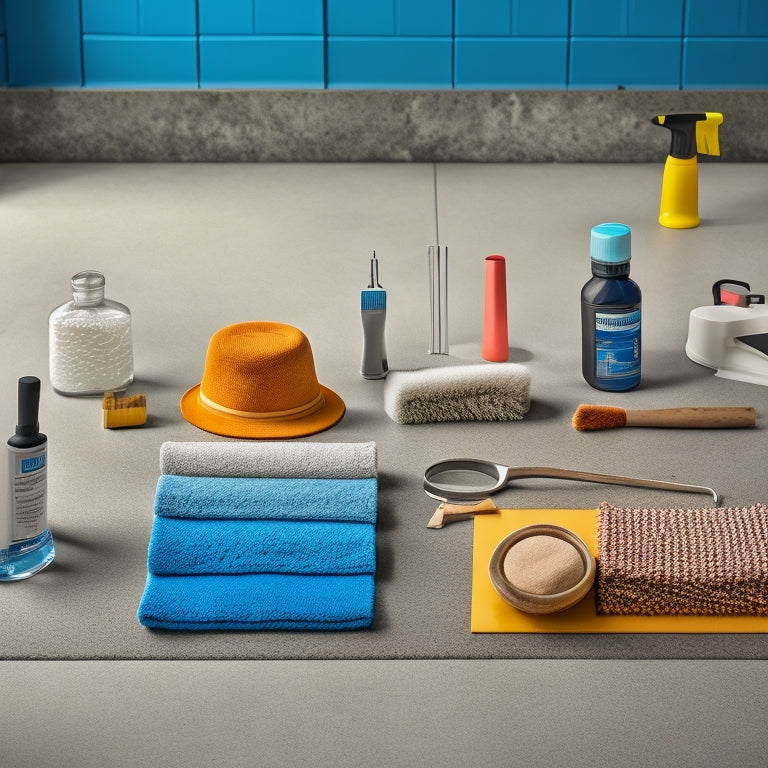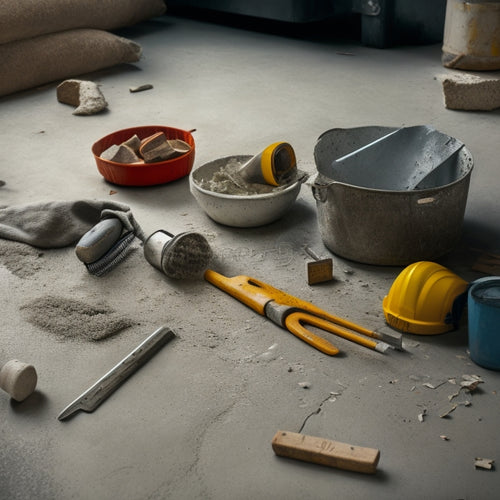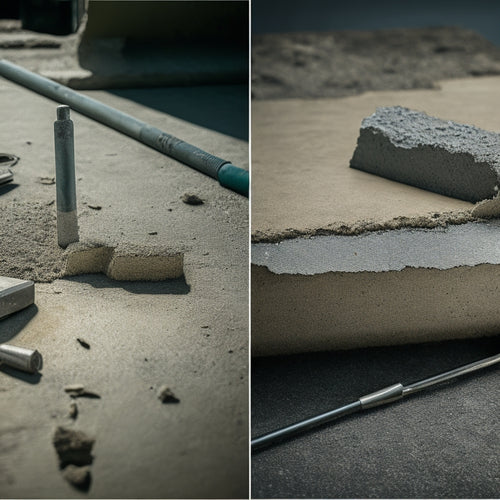
Top Concrete Sealer Applicator Tools for Easy Application
Share
When applying concrete sealers, using the right tools is essential for achieving a professional-grade finish with minimal effort. For large areas, laminate roller extension poles and push broom applicators provide extended reach and efficient application. Microfiber applicator mops offer superior absorbency and even sealer distribution. Sprayer wand extensions and handheld sealant applicators enable precise control, while sealcoat squeegee tools and pressure washer attachments help remove excess sealer and clean surfaces. With the right tools, you'll be well on your way to a successful sealing project. Now, discover how to choose the best tools for your specific project needs.
Key Takeaways
• Laminate roller extension poles provide extended reach and reduce physical strain for efficient and comfortable application.
• Microfiber applicator mops offer superior absorbency and even sealer distribution for a professional-grade finish.
• Brush selection is crucial, considering bristle material, size, and stiffness to ensure effective application and desired finish quality.
• Sprayer wand extensions and notched squeegee edges are essential for reaching hard-to-access areas and achieving consistent finishes.
• Pressure washer attachments and pump-up sprayer systems enable efficient cleaning and application for small to medium-sized projects.
Laminate Roller Extension Poles
When applying a concrete sealer, you'll often reach for a laminate roller extension pole, a versatile tool that allows you to coat large areas quickly and evenly while minimizing physical strain. This is because laminate roller extension poles offer several advantages, including extended reach and reduced fatigue.
With a laminate roller, you can cover large surfaces without constantly bending or straining, making the application process more efficient and comfortable.
To get the most out of your laminate roller, it's important to master proper techniques. Start by loading the roller with the recommended amount of sealer, then work in sections to maintain even coverage.
Use long, smooth strokes to apply the sealer, working in a consistent pattern to avoid overlap or missed spots. By using a laminate roller extension pole and following these techniques, you'll achieve a professional-grade finish with minimal effort.
With its ease of use and ability to cover large areas quickly, the laminate roller is an important tool for any concrete sealer application project.
Microfiber Applicator Mops
When you're working with microfiber applicator mops, you'll want to pay close attention to the mop head material, as it directly impacts the tool's performance.
You'll find that absorbency is a key factor in getting the job done efficiently, so look for mops with high-quality microfiber that can hold a lot of sealer.
Mop Head Material Matters
You'll find that microfiber applicator mops outperform traditional string mops in sealing concrete, mainly due to their superior absorbency and ability to hold a consistent, even layer of sealer. This is because microfiber mop heads are made up of millions of tiny fibers that work together to absorb and distribute the sealer evenly.
As a result, you'll experience better mop performance and durability. The microfiber material is also less prone to shedding or leaving behind lint, which can compromise the sealant's adhesion.
Additionally, microfiber mops are generally easier to clean and maintain, reducing the risk of cross-contamination and extending their lifespan.
When choosing a microfiber applicator mop, look for high-quality materials that can withstand the demands of concrete sealing. A well-made microfiber mop will provide you with consistent results, job after job.
Absorbency Is Key Factor
Microfiber applicator mops' superior absorbency is the primary reason they outshine traditional string mops, as it enables them to hold a consistent, even layer of sealer that's essential for achieving a professional-grade finish.
When you use a microfiber applicator mop, you can be confident that the sealer will penetrate evenly, resulting in a uniform finish. This is because microfiber's high absorbency techniques allow it to hold a generous amount of sealer, which is then released consistently as you apply it to the concrete surface.
The sealer penetration is also enhanced by the microfiber's ability to absorb and hold the sealer without dripping or running, guaranteeing that the sealer is applied in a controlled manner.
This controlled application prevents puddling, which can lead to uneven finishes and wasted sealer. With a microfiber applicator mop, you can achieve a smooth, even finish that meets professional standards.
Easy to Clean Design
Cleanliness is a crucial aspect of maintaining your microfiber applicator mop, and its easy-to-clean design makes it a breeze to rinse and reuse, saving you time and effort in the long run. You'll appreciate the simplicity of cleaning your mop, allowing you to focus on the application process. To get the most out of your microfiber applicator mop, it's important to follow proper cleaning techniques and maintenance tips.
Here are some key benefits of an easy-to-clean design:
| Feature | Benefit | Result |
|---|---|---|
| Quick rinse | Removes dirt and debris | Extends mop lifespan |
| Reusable design | Reduces waste and cost | Environmentally friendly |
| Easy wring-out | Minimizes water usage | Saves resources |
| Machine washable | Deep cleans the mop | Removes embedded dirt |
| Fast drying | Prevents bacterial growth | Maintains hygiene |
Sprayer Wand Extensions
Your sprayer wand extensions play an essential role in ensuring efficient and effective concrete sealer application by allowing you to reach remote or hard-to-access areas.
With various sprayer wand types and lengths available, you can tailor your application process to suit specific job requirements. For instance, you can opt for a longer sprayer wand extension to reach high ceilings or tight spaces, or choose a shorter one for more precise control in smaller areas.
When selecting a sprayer wand extension, consider the material it's made of, as well as its durability and resistance to corrosion. Stainless steel or fiberglass extensions are ideal for withstanding harsh chemicals and heavy use.
Additionally, look for extensions with adjustable nozzles, allowing you to customize the spray pattern and flow rate to achieve ideal results.
Sealcoat Squeegee Tools
When applying concrete sealers, you'll find sealcoat squeegee tools indispensable for efficiently removing excess sealer from freshly coated surfaces.
These tools are designed to promote even sealcoat application techniques, ensuring a uniform finish and preventing pooling or puddling. By using a sealcoat squeegee, you can achieve the best results while minimizing waste and reducing cleanup time.
Sealcoat squeegees are typically made of durable materials, such as rubber or polyurethane, and come in various sizes to accommodate different project requirements.
They feature a flat, wide blade that allows for efficient sealer removal, and some models may include adjustable handles for added comfort and control.
When using a sealcoat squeegee, it's crucial to work in sections, applying gentle to moderate pressure to remove excess sealer.
This helps to prevent over-working the sealer, which can lead to uneven drying times and compromised performance.
Pressure Washer Attachments
You'll often find pressure washer attachments vital for effectively removing dirt, grime, and old sealers from concrete surfaces before reapplying a new coat of sealer. These attachments provide numerous pressure washer benefits, including increased efficiency and effectiveness in cleaning concrete surfaces.
With the right attachment, you can target specific areas, such as tight spaces or delicate surfaces, with precision and control.
When choosing a pressure washer attachment, consider the surface you're working with and the level of cleaning required. Wide fan tips are ideal for large areas, while narrow fan tips are better suited for smaller spaces. Additionally, rotating nozzles can be used for more aggressive cleaning.
Regular pressure washer maintenance is essential to guarantee peak performance and extend the lifespan of your equipment. Make sure to regularly inspect and clean your attachments, as well as store them properly when not in use.
Concrete Sealer Brushes
When you're selecting a concrete sealer brush, you'll want to contemplate the type of bristle material, as it affects the sealer's absorption rate.
You'll also need to reflect on the brush size, which impacts the evenness of the application and the amount of sealer used.
Brush Bristle Material Matters
Frequently, the performance and longevity of a concrete sealer brush hinge on the quality of its bristle material, which greatly impacts the overall application process.
You'll find that different brush types are designed with specific bristle materials to suit various sealer application needs. For instance, natural bristle brushes are ideal for solvent-based sealers, as they absorb the solvent and allow for a smooth, even application. On the other hand, nylon or polyester bristle brushes are better suited for water-based sealers, as they resist water absorption and minimize sealer dripping.
The bristle stiffness also plays a significant role in the application process. Softer bristles are perfect for applying sealers to rough or porous surfaces, while stiffer bristles are better for smooth surfaces.
You'll need to take into account the surface type and sealer viscosity when choosing the right brush. By selecting the appropriate brush with the correct bristle material and stiffness, you'll achieve a uniform coat, reduce waste, and guarantee a successful application.
Sealer Absorption Control
Sealer Absorption Control
To maintain a consistent, even coat and prevent sealer waste, controlling sealer absorption is essential, and the right concrete sealer brush can make all the difference. You need a brush that can effectively manage the sealer's flow and absorption rate, ensuring a uniform finish. This is particularly important when working with different sealer types, as they have varying viscosities and absorption rates.
| Sealer Type | Recommended Brush Features |
|---|---|
| Acrylic | Soft bristles, smaller brush size for controlled flow |
| Polyurethane | Stiff bristles, medium-sized brush for balanced flow |
| Silane | Coarse bristles, larger brush size for fast flow |
When it comes to surface preparation, a good concrete sealer brush should be able to handle the texture and porosity of the concrete. Look for a brush that can effectively push the sealer into the pores, ensuring maximum penetration and adhesion. By choosing the right brush, you'll be able to achieve a professional-looking finish and maximize the effectiveness of your sealer.
Brush Size Importance
Selecting the correct brush size is essential, as it directly impacts the effective application and even distribution of the concrete sealer, allowing you to achieve a uniform finish and ideal results.
When it comes to brush width comparison, a larger brush may seem like the best option, but it can lead to excessive sealer application, resulting in a thick, uneven finish. On the other hand, a smaller brush may require more strokes, increasing the risk of lap marks and unevenness.
As a general rule, a brush with a width of 12-18 inches is suitable for most concrete sealer applications. However, it's vital to take into account the specific requirements of your project, including the size of the area, the type of concrete, and the desired finish.
Additionally, brush material types play a significant role in the application process. Natural fiber brushes, such as china bristle or natural fiber, are ideal for solvent-based sealers, while synthetic brushes work better with water-based sealers.
Pump-Up Sprayer Systems
When you opt for a pump-up sprayer system, you'll find that it provides an efficient and cost-effective way to apply concrete sealers, especially for small to medium-sized projects. This system consists of a tank, pump, and spray wand, allowing you to cover a significant area quickly. With pump-up sprayers, you can achieve a uniform coating and minimize waste.
There are two main types of sealer pumps: diaphragm and piston pumps. Diaphragm pumps are ideal for low-viscosity sealers, while piston pumps are better suited for thicker, more viscous materials.
Here are some key considerations for choosing the right pump-up sprayer system:
| Feature | Consideration |
|---|---|
| Sealer Type | Diaphragm pump for low-viscosity, piston pump for high-viscosity |
| Project Size | Small to medium-sized projects (up to 1,000 sq. ft.) |
| Maintenance | Regularly clean and lubricate pump, inspect and replace worn parts |
To guarantee peak performance and extend the life of your pump-up sprayer, remember to follow proper sprayer maintenance tips, such as regular cleaning and lubrication. By selecting the right pump-up sprayer system and following proper maintenance procedures, you'll achieve professional-looking results with ease.
Push Broom Applicators
For larger projects or those requiring a more aggressive application, consider using push broom applicators, which can cover more ground and apply concrete sealers with greater force than pump-up sprayer systems.
With push broom applicators, you'll experience the benefits of increased productivity and efficiency. By applying sealers with a push broom, you can cover larger areas quickly, making them ideal for large-scale projects.
One of the significant push broom benefits is the ability to apply sealers in a uniform, even layer. This is achieved through the use of push broom techniques, such as maintaining a consistent pace and applying gentle to moderate pressure.
Additionally, push brooms allow for better control over the application process, reducing the risk of over-saturation and uneven coverage.
When using a push broom applicator, make sure to choose the right broom head size and type for your specific project, and always follow the manufacturer's instructions for the best results.
Notched Squeegee Edges
You'll often find notched squeegee edges to be the go-to tool for applying concrete sealers to smooth surfaces, as they allow for a smooth, even flow of material. This is especially true when working with denser sealers or those with a higher viscosity. Notched squeegees are designed to spread the sealer evenly, guaranteeing a consistent finish.
| Notched Squeegee Benefits | Squeegee Application Techniques |
|---|---|
| Even material distribution | Use long, smooth strokes to cover large areas |
| Reduced labor time | Apply gentle to moderate pressure, depending on sealer viscosity |
| Smooth, consistent finish | Work in sections to maintain even coverage |
| Easy cleanup | Use a clean, dry cloth to wipe excess sealer from the squeegee |
| Versatility with various sealer types | Experiment with different notch sizes and angles for best results |
When using a notched squeegee, it is crucial to maintain a consistent angle and apply even pressure. This guarantees the sealer is spread evenly and prevents pooling or unevenness. By mastering notched squeegee application techniques, you'll achieve a professional-looking finish with minimal effort.
Handheld Sealant Applicators
When selecting a handheld sealant applicator, you'll want to evaluate the tool's ability to control sealant flow, ensuring a consistent and even application.
Adjustable spray nozzles are also a key feature to look for, as they allow you to adapt to varying surface textures and patterns.
Additionally, a compact design is essential, as it enables you to work efficiently in tight spaces and reduces fatigue during extended use.
Sealant Flow Control
Sealant Flow Control
By selecting the right handheld sealant applicator, you can effectively regulate sealant flow control, achieving a consistent, even coat on your concrete surface. This is essential, as it directly impacts the overall performance and durability of the sealant.
When it comes to sealant flow control, you need to take into account the sealant viscosity and application techniques. Thicker sealants require more pressure to flow smoothly, while thinner ones may flow too quickly, leading to uneven coverage.
Here's a comparison of popular handheld sealant applicators for effective sealant flow control:
| Applicator Type | Sealant Viscosity | Flow Control |
|---|---|---|
| Pistol Grip | Medium to High | Adjustable needle valve |
| Squeeze Bottle | Low to Medium | Manual squeeze control |
| Caulk Gun | High | Trigger-controlled flow |
Adjustable Spray Nozzles
By pairing the right handheld sealant applicator with an adjustable spray nozzle, you can fine-tune the sealant flow control even further, ensuring a uniform application on your concrete surface. This combination allows you to achieve the best sealant distribution, reducing waste and ensuring a professional-looking finish.
Adjustable nozzle types come in various forms, including fan, cone, and mist nozzles. Each type offers unique spray pattern variations, allowing you to tailor the application to your specific needs.
For example, fan nozzles provide a wide, flat spray pattern, ideal for large, flat surfaces, while cone nozzles deliver a concentrated, circular spray pattern, perfect for small, intricate areas.
Compact Design Matters
You'll appreciate the benefits of a compact handheld sealant applicator, which fits comfortably in your hand and allows for precise control and maneuverability in tight spaces. The compact design benefits of these tools are undeniable, making them ideal for applying concrete sealers in areas with limited access.
The compact design versatility of handheld applicators enables you to navigate corners, edges, and other hard-to-reach areas with ease. This results in a more efficient and effective application process.
Here are some key advantages of compact handheld sealant applicators:
-
Improved precision: Compact design allows for better control over the application process, reducing waste and ensuring a smooth, even finish.
-
Increased accessibility: Handheld applicators can reach areas that larger tools cannot, making them perfect for applying sealers to small, intricate spaces.
-
Enhanced portability: Compact design makes these tools easy to transport and store, reducing fatigue and increasing productivity.
Frequently Asked Questions
Can I Use a Concrete Sealer Applicator Tool With Epoxy-Based Sealers?
You can use a concrete sealer applicator tool with epoxy-based sealers, but make certain the tool is compatible with epoxy; some applicators, like rollers or brushes, may not work well, while others, like squeegees or notched trowels, are suitable.
How Often Should I Clean and Maintain My Concrete Sealer Tools?
You should clean and maintain your concrete sealer tools after every use to prevent sealer buildup and guarantee tool longevity; follow these maintenance tips: wash with soap and water, dry thoroughly, and store in a clean, dry place.
Are Concrete Sealer Applicator Tools Suitable for All Types of Concrete?
Like a master painter, you must consider the canvas - in this case, the concrete surface type. Not all concrete sealer applicator tools are compatible with every surface, so make certain you choose a tool that's tailored to your specific concrete surface type for best results.
Can I Apply Concrete Sealer in Direct Sunlight or High Winds?
You should avoid applying concrete sealer in direct sunlight, as it can cause uneven drying and affect adhesion. Additionally, high wind challenges can disrupt even application, so it's best to apply in shaded, windless conditions.
Do I Need to Wear Protective Gear When Using Concrete Sealer Applicators?
When using concrete sealer applicators, you should always wear protective gear, including gloves, safety glasses, and a mask, to take necessary safety precautions and minimize exposure to harsh chemicals and potential health risks.
Conclusion
You've got the right tools in your arsenal to tackle that concrete sealing project like a pro.
With these high-quality applicators, you'll be rolling out a smooth, sealed surface in no time.
Imagine a freshly sealed concrete floor, glistening like a newly polished gemstone, and you'll be the master craftsman behind the magic.
Now, get out there and seal like a boss!
Related Posts
-

Top 10 Concrete Repair Tools for Small Fixes
You'll need the right tools to tackle small concrete repairs efficiently and effectively. When it comes to small fixe...
-

Free Design Tools for Concrete House Planning
You can kick-start your concrete house planning project without breaking the bank, as there are several free design t...
-

Top Tools for Concrete Adhesion Success
When it comes to concrete adhesion success, you'll need to wield the right tools and techniques to guarantee a strong...


